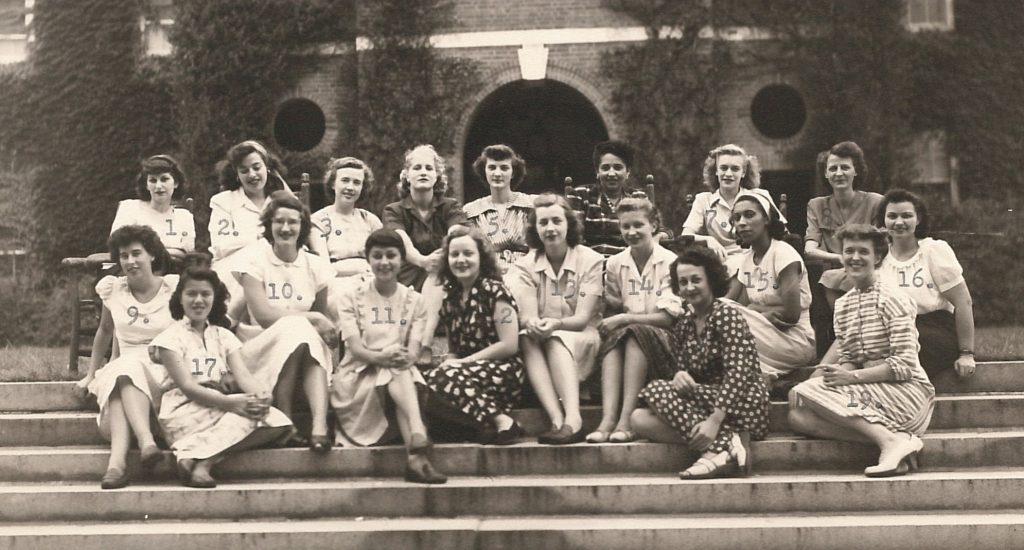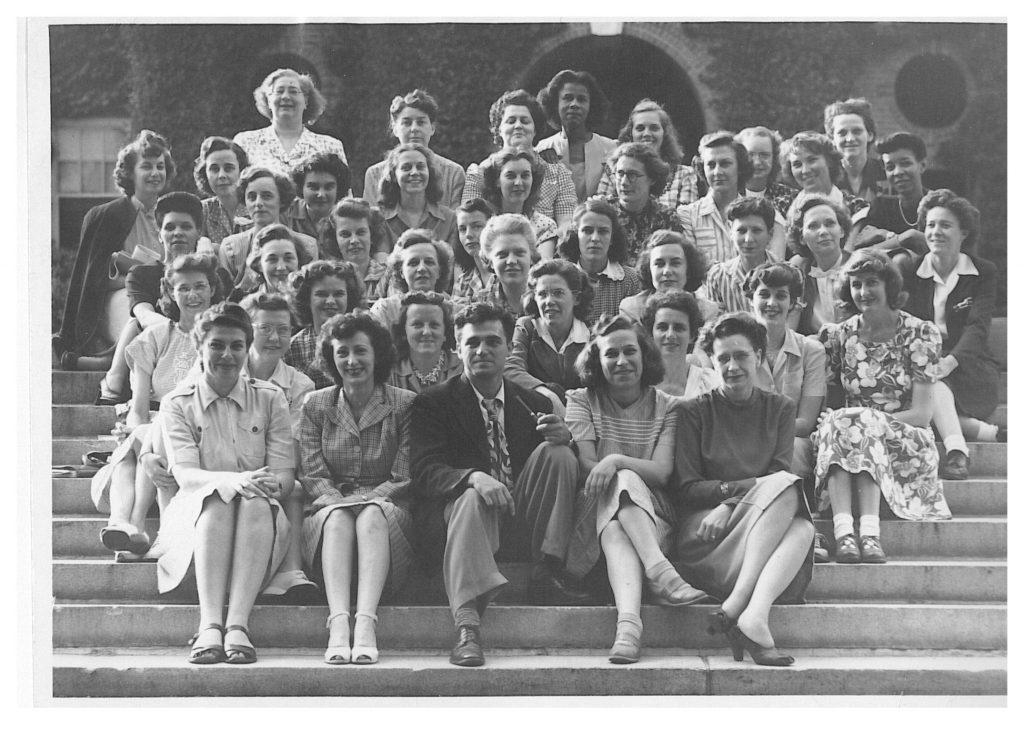[et_pb_section bb_built=”1″ admin_label=”section” background_image=”https://sites.smith.edu/ssw100-history/wp-content/uploads/sites/256/2018/05/1947-Plan-A-2nd-year-Class-Photo-SSW-office.jpg” background_color=”rgba(0,62,81,0.55)” parallax_method=”off” next_background_color=”#ffffff” custom_padding_tablet=”50px|0|50px|0″ custom_padding_last_edited=”on|desktop” _builder_version=”3.2.2″ background_blend=”overlay”][et_pb_row admin_label=”row” background_position=”top_left” background_repeat=”repeat” background_size=”initial”][et_pb_column type=”1_3″][/et_pb_column][et_pb_column type=”2_3″][et_pb_divider color=”#ffffff” show_divider=”off” height=”200″ divider_style=”solid” divider_position=”top” hide_on_mobile=”on” disabled_on=”on|on|off” _builder_version=”3.2.2″ /][et_pb_post_title _builder_version=”3.2.2″ meta=”off” featured_image=”off” text_color=”light” title_font_size=”50px” title_line_height=”1.2em” /][/et_pb_column][/et_pb_row][/et_pb_section][et_pb_section bb_built=”1″ specialty=”off” parallax_method=”off” prev_background_color=”rgba(0,62,81,0.55)” custom_padding_tablet=”50px|0|50px|0″ custom_padding_last_edited=”on|desktop” _builder_version=”3.2.2″][et_pb_row admin_label=”row” make_fullwidth=”off” use_custom_width=”off” width_unit=”on” use_custom_gutter=”off” custom_padding=”0px|||” padding_mobile=”on” allow_player_pause=”off” parallax=”off” parallax_method=”off” make_equal=”off” parallax_1=”off” parallax_method_1=”off” parallax_2=”off” parallax_method_2=”off” column_padding_mobile=”on” background_position=”top_left” background_repeat=”repeat” background_size=”initial”][et_pb_column type=”1_3″][et_pb_post_title admin_label=”Categories” _builder_version=”3.2.2″ title=”off” author=”off” date=”off” comments=”off” featured_image=”off” meta_text_color=”#6fbee5″ /][et_pb_code admin_label=”Tags” _builder_version=”3.2.2″][tags][/et_pb_code][/et_pb_column][et_pb_column type=”2_3″][et_pb_text max_width=”620px” text_font_size=”20″ text_text_color=”#363636″ use_border_color=”off” custom_margin=”10px||0px|” text_line_height=”1.4em” text_font_size_last_edited=”on|desktop” background_position=”top_left” background_repeat=”repeat” background_size=”initial” _builder_version=”3.2.2″]
For most of SSW’s first 100 years, it had a Plan A and a Plan B. Plan C and Plan D made brief appearances. This post explains the differences and gives an overview of transformations in the SSW curriculum.
[/et_pb_text][/et_pb_column][/et_pb_row][et_pb_row admin_label=”row” make_fullwidth=”off” use_custom_width=”off” width_unit=”on” use_custom_gutter=”off” custom_padding=”0px|||” padding_mobile=”on” allow_player_pause=”off” parallax=”off” parallax_method=”off” make_equal=”off” parallax_1=”off” parallax_method_1=”off” parallax_2=”off” parallax_method_2=”off” column_padding_mobile=”on” background_position=”top_left” background_repeat=”repeat” background_size=”initial” _builder_version=”3.2.2″][et_pb_column type=”1_3″][/et_pb_column][et_pb_column type=”2_3″][et_pb_text text_font_size=”20″ text_text_color=”#363636″ use_border_color=”off” custom_margin=”30px||0px|” text_line_height=”1.5em” text_font_size_last_edited=”on|phone” background_position=”top_left” background_repeat=”repeat” background_size=”initial” _builder_version=”3.2.2″ text_font_size_tablet=”14″ text_font_size_phone=”12″]
From the very first session, the SSW founders acknowledged that their students came to them with a wide variety of experience and education. This was particularly true because relatively few women had college educations and most people working as social workers had been trained on the job. Initially, the administration recognized this variety by individually judging each application for the student’s level of education and experience.
[/et_pb_text][/et_pb_column][/et_pb_row][et_pb_row][et_pb_column type=”4_4″][et_pb_text _builder_version=”3.2.2″]

[/et_pb_text][/et_pb_column][/et_pb_row][et_pb_row admin_label=”row” make_fullwidth=”off” use_custom_width=”off” width_unit=”on” use_custom_gutter=”off” custom_padding=”0px|||” padding_mobile=”on” allow_player_pause=”off” parallax=”off” parallax_method=”off” make_equal=”off” parallax_1=”off” parallax_method_1=”off” parallax_2=”off” parallax_method_2=”off” column_padding_mobile=”on” background_position=”top_left” background_repeat=”repeat” background_size=”initial” _builder_version=”3.2.2″][et_pb_column type=”1_3″][/et_pb_column][et_pb_column type=”2_3″][et_pb_text _builder_version=”3.2.2″ text_font_size=”20px” text_font_size_phone=”12px” text_font_size_last_edited=”on|phone”]
In 1933, Everett Kimball and Bertha Capen Reynolds introduced Plans A and B to make two formal tracks for those with experience and those without. Plan A was open to students who had the right academic qualifications* but no experience. It lasted for three summers of academic work and two winters of supervised field training. Plan B was an accelerated program for those with experience that the School deemed equivalent to the first year of Plan A. They could complete the Masters of Social Science in fourteen months (two summers and one winter). In addition, Plan C was for students with experience who did not wish to obtain the Masters, but rather only study for one summer. If they wanted to pursue the Masters later, they could receive credit for their one summer of study. Reynolds introduced Plan D in 1935 as a way for students with an M.S.S. to obtain training on educating social workers themselves.
[/et_pb_text][/et_pb_column][/et_pb_row][et_pb_row][et_pb_column type=”4_4″][et_pb_text _builder_version=”3.2.2″]

[/et_pb_text][/et_pb_column][/et_pb_row][et_pb_row][et_pb_column type=”1_3″][/et_pb_column][et_pb_column type=”2_3″][et_pb_text text_font_size=”20″ text_text_color=”#363636″ use_border_color=”off” custom_margin=”30px||0px|” text_line_height=”1.5em” text_font_size_last_edited=”on|phone” background_position=”top_left” background_repeat=”repeat” background_size=”initial” _builder_version=”3.2.2″ text_font_size_phone=”12″]
Plans A and B stayed basically the same while Continuing Education and the Program for Advanced Study and Ph.D. Program experienced significant change for the next fifty years. In 1988, Plan A was divided into an option for students with a Bachelors of Social Work (BSW) and an option for those without. In just a few years, it became clear SSW was more likely to receive students with BSW than those who would enter Plan B, i.e. those with sufficient experience but no M.S.W. In 1994, SSW ended Plan B and replaced it with the normal program and the advanced program for those with BSWs.
[/et_pb_text][/et_pb_column][/et_pb_row][/et_pb_section]

Comments are closed.